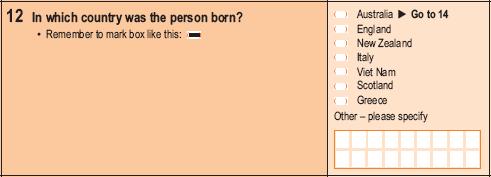|
|
Country of Birth of Person
On this page:
Description
Image of Question
Classification
Quality Statement
Description
There are three country of birth variables:
- Country of Birth of Person (BPLP), which records a person's country of birth;
- Country of Birth of Mother (BPFP), which indicates whether a person's mother was born in Australia or overseas, and;
- Country of Birth of Father (BPMP), which indicate whether a person's father was born in Australia or overseas.
In Censuses prior to 2006, these variables were referred to as 'Birthplace' rather than 'Country of birth'. More Detailed Description
Image of Question
 Classification
Classification
- Oceania and Antarctica
- North-West Europe
- Southern and Eastern Europe
- North Africa and the Middle East
- South-East Asia
- North-East Asia
- Southern and Central Asia
- Americas
- Sub-Saharan Africa
Supplementary Codes:
0000. Inadequately described
0001. At sea
0002. Not elsewhere classified
&&&& Not stated
VVVV Overseas visitor
Total number of categories:
one digit level 9
two digit level 36
four digit level 284
More Detailed Description
Quality Statement - Country of Birth of Person (BPLP)
There are many aspects which can affect the quality of census data. The following information should be considered when viewing data on Country of Birth of Person (BPLP).
Note: Prior to 2006, this variable was referred to as Birthplace of Individual rather than Country of Birth of Person.
Most of the data (87.1%) was captured automatically from mark-box responses, so the risk of processing error is minimal. The remainder (written responses), were coded by an automatic reading and coding process (12.4%), or coded clerically (0.5%). All coding was subject to sample checks to ensure an acceptable level of quality.
The non-response rate for 2006 was 6.9% compared with 5.5% for 2001. This increase is partly attributable to the 4.2% of persons in dwellings which were occupied on Census Night, but did not return a completed form. Persons were imputed into these dwellings together with some demographic characteristics. However, the values for Country of Birth of Person (BPLP) remain not stated. In 2006, 2.8% of persons (552,240) returned a form but did not answer the country of birth question. In 2001, 2.1% of persons were imputed into dwellings for which no form was received.
In a small number of cases where country of birth was not stated, the category 'born in Australia' was derived. This occurred when the person's father or mother was counted in the same dwelling and reported that they were born in Australia. Derivation is the process where some variables (where no response has been provided), are assigned values based on responses from other family members present in the same dwelling. Variables that may be derived from responses given by other family members present in the same dwelling are:
- Country of Birth of Person (BPLP)
- Country of Birth of Father (BPMP)
- Country of Birth of Mother (BPFP)
- Language Spoken at Home (LANP).
If insufficient information is provided to derive a response for these items, they are determined to be 'Not stated'.
Inadequately described responses (written responses unable to be coded), comprised 0.06% of the data, down from 0.10% in 2001.
In a small proportion of cases (testing has indicated that this is less than 1%), respondents provided an incorrect number of responses (for BPLP, respondents were asked to only mark one response). In these cases, responses were accepted in the order they appeared on the form and the extra responses were rejected.
The Standard Australian Classification of Countries (SACC), used to code birthplace responses from the 2006 Census has been updated to reflect changes in official names and regional alliances between censuses. Since the 2001 Census, the Federal Republic of Yugoslavia ceased to exist, and in June 2006, Serbia and Montenegro separated. However, many persons recorded their birthplace as Yugoslavia (33,028) and these were coded to South Eastern Europe, nfd. This is the major contributing factor to the increase in the number of persons recorded in this category between 2001 and 2006, as shown in the following table.
| SACC category | 2001 Census | 2006 Census |
| 3200 South Eastern Europe, nfd | 4,758 | 33,357 |
| 3213 Federal Republic of Yugoslavia | 55,365 | n/a |
| 3214 Montenegro | n/a | 847 |
| 3215 Serbia | n/a | 17,328 |
n/a not applicable
Note: For users wanting to compare data relating to people born in Serbia across censuses, an alternative option would be to use ancestry data (ANCP).
A question on country of birth is included in most ABS population surveys, although detailed birthplace information is not available from these surveys because of high sampling error on estimates for small geographic areas and for many small birthplace groups.
Additional sources of country of birth information are available from ABS publications and associated collections, including:
- Australian Labour Statistics, Apr 2004 (cat. no. 6105.0), which contains a feature article titled: Spotlight on Country of Birth
- Australian Demographic Statistics, Sep 2004 (cat. no. 3101.0), which contains a feature article titled: Population by Country of Birth
- Australian Social Trends (various years) (cat. no. 4102.0), which contain a number of articles relating to country of birth
- Perspectives on Migrants, 2007 (cat. no. 3416.0), which contains country of birth data in a series of articles about a range of migrant and ethnicity related issues.
Regular statistics on overseas arrivals and departures classified by country of birth are available from passenger cards required to be completed by each person entering or leaving Australia. |
The ABS aims to produce high quality data from the census. To achieve this, extensive effort is put into census form design, collection procedures, and processing procedures. More details regarding these efforts can be found in:
All are available from the ABS Website. |
|
|
 Print Page
Print Page